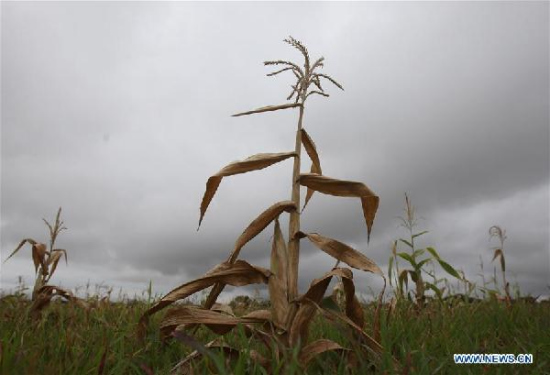
Withered crops are seen at a farmland in the drought-hit Masvingo province, southern Zimbabwe, Jan. 26, 2016. (Xinhua/Stringer)
The number of major droughts recorded globally in 2015 was more than double the ten-year average, due to a severe El Nino weather event, the top UN disaster risk official said Wednesday.
The effects of the droughts are still being felt with millions of people on opposite sides of the world experiencing hunger from Ethiopia, in Eastern Africa, to Papua New Guinea, in Oceania, said Robert Glasser, the special representative of the UN secretary-general for disaster risk reduction, at a press conference here.
"El Ninos and La Ninas are these frequent cycles and what happens when they strike is that we have simultaneous disasters in different places in the world," he said.
El Nino -- which means the Little Boy in Spanish -- and its sister La Nina -- the Little Girl -- are weather events, which contribute to changes in climate and weather.
"We're seeing more extreme El Ninos and the frequency is increasing as well," said Glasser. "The 2015 El Nino -- which is now beginning to decrease -- was one of the most severe El Ninos we've experienced globally."
Glasser added that the El Ninos are occurring on the back of climate change, which saw global temperatures in 2015 rising to one degree above pre-industrial levels.
Glasser said that the exact relationship between climate change and the increasing severity and frequency of El Ninos and La Ninas is currently subject to intense scientific study.
"There's some very convincing peer reviewed scientific research that suggests that climate change is going to increase the frequency and severity (of) El Ninos and La Ninas," he said, noting that there is not yet scientific consensus on the issue.
While in Indonesia, peat fires which have become worse due to El Nino weather conditions are also creating a cycle which will see climate change worsen, he said.
"The Indonesian drought has led to peat fires -- which again are a very serious issue -- (and) also releasing huge amounts of greenhouse gases," said Glasser.
In some cases, the fires have been deliberately lit to clear forest for farming. However, the El Nino conditions mean that they have become extremely difficult to put out, he said.
By one estimate, the Indonesia fires were producing greenhouse emissions equivalent to the United States, said Glasser.
"It's a huge additional impact in terms of CO2 and the enormous health impacts for not just people in Indonesia but also for the ... neighboring countries," he said.


















































